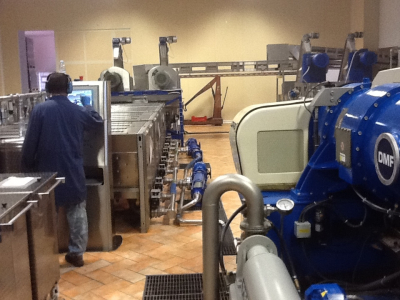Bioconversion of olive mill waste waters
Expertise. How to manage vegetation water? Their direct application on agricultural lands brings positive effects but negative too. What to do? The aerobic treatments seem to be a solution. Up to now it has been tested a number of microorganisms, used in pure culture or pool cultivation. Also the composting represents a further useful strategy

BIOLOGICAL APPROACHES FOR THE BIOCONVERSION OF OLIVE MILL WASTE WATERS
AUTHORS
Dipartimento di Scienze Agrarie, Alimentari ed Ambientali (D3A), Università Politecnica delle Marche, Ancona: Lucia Aquilanti, Andrea Osimani, Manuela Taccari, Cristiana Garofalo, Massimo Mozzon, Francesca Clementi
Dipartimento di Scienze della Vita e dell’Ambiente (DiSVA), Università Politecnica delle Marche, Ancona: Maurizio Ciani
The extraction of olive oil is principally performed by discontinuous (press-based) or continuous (centrifugation-based) technologies, which lead to the production of both solid (olive husk or olive pomace) and liquid (olive mill wastewater, OMW) waste products (except for two-phase centrifugation systems which produce only solid residues) (Otles and Selek, 2012). OMW is characterized by a high content of inorganic salts, principally phosphates, and organic matter (COD, 50 – 150 g L_1) consisting of nitrogenous compounds, organic acids, sugars, tannins, pectins, carotenoids, oil residues, and phenolic substances (Piperidou et al., 2000; Mekki et al., 2006; Piotrowska et al., 2006; Anastasiou et al., 2011).
In the last decades, the remarkable increase in olive oil production has rendered the disposal and treatment of OMW a serious problem for the olive oil industry (Rozzi and Malpei, 1996). Controlled land spreading of untreated OMW undoubtedly represents the simplest and most economical strategy for the management and disposal of this by-product. However, the direct application of OMW on agricultural soils results in either positive or negative effects, the latter being mainly ascribable to the high mineral content, low pH, and great abundance of compounds with phytotoxic and antimicrobial activities (Otles and Selek, 2012). Accordingly, a number of physical, physicochemical and even biological strategies have been proposed for the treatment of OMW; among these, biological processes including aerobic treatments with selected microorganisms and composting are undoubtedly the most environmentally compatible and the least expensive (Mantzavinos and Kalogerakis, 2005). Aerobic treatments are primarily aimed at degrading a fraction of the OMW pollutants through an oxidative process. To date, a number of bacteria have been assayed, either alone or in consortia, for the aerobic treatment of OMW; these include members of the genera Arthrobacter, Sphingomonas, Ralstonia, Bacillus, Pseudomonas, and Azotobacter (Di Gioia et al., 2001; Ehaliotis et al., 1999; Knupp et al., 1996; Ramos-Cormenzana et al., 1996). The latter are free-living nitrogen-fixing bacteria, which are broadly dispersed in neutral to alkaline soils, water and sediments. Due to the low content in nitrogenous organic compounds and richness in carbon sources, OMW is an ideal substrate for the growth of azotobacteria. Isolates of either Azotobacter chroococcum or Azotobacter vinelandii proved to actively grow (García-Barrionuevo et al., 1992) and fix atmospheric nitrogen (Balis et al., 1996; Papadelli et al., 1996) in sterile undiluted OMW, and both species were found to use aromatic compounds as a carbon and energy source (Anastasiou et al., 2011). The capacity of A. vinelandii to produce fertility-promoting metabolites (Fiorelli et al., 1996) and exopolysaccharides (Niaounakis and Halvadakis, 2006) in diluted OMW has also been demonstrated. In Greece, an isolate of A. vinelandii (strain A) has been exploited in a pilot plant for the aerobic treatment of OMW, with very promising results in terms of removal of phytotoxic compounds (Piperidou et al., 2000).
Composting is a further biological technology for the disposal of OMW; it enables the recycling of organic matter through the activity of the endogenous microbiota of the composted solid matrix. Thanks to its high content in carbon and humic substances, compost has a high fertilizing and soil conditioning value (Hachicha et al., 2008). A considerable bibliography exists on the composting of OMW (Hachicha et al., 2008; Aviani et al., 2010; Cayuela et al., 2010; Altieri et al., 2011; Federici et al., 2011; Taccari et al., 2009; Taccari et al., 2011; Aquilanti et al., 2014) and sound evidence is available on the fertilizingcapacity of compost obtained from this agro-industrial waste (Mantzavinos and Kalogerakis, 2005; Taccari et al., 2009; Taccari et al., 2011; Aquilanti et al., 2014). However, relatively few data are available on the application of OMW during prolonged composting (exceeding 4 months) (Hachicha et al., 2008; Aquilanti et al., 2014) and, to the best of our knowledge, no feasibility studies on the combination of composting with a biological pre-treatment of OMW have yet been carried out.
DRAFT OF A POTENTIAL RESEARCH ACTIVITIES
Based on the above premises, integrated biological approaches (aerobic/anaerobic pre-treatments, composting), relying on the exploitation of microbial consortia, including N2-fixing bacteria, moulds and/or yeasts might be assayed in both laboratory- and pilot-scale trials for the agricultural exploitation of this agro-industrial waste.
Different analytical tests could be performed to monitor processes and products (bioferment, mature compost); these will be aimed at determining: (i) viable counts of selected microbial groups (e.g. free nitrogen-fixing bacteria; moulds, yeasts.; (ii) microbiological activity; (iii) microbial dynamics (e.g. through PCR-DGGE, PCR-TGGE); (iv) content in total organic matter (COD); (v) content in total polyphenols and/or specific phenolic fractions; (vi) temperature; (vii) germination and phytotoxicity (for mature compost, treated OMW); (viii) content in soluble nitrogen/total nitrogen (for mature compost).
Bibliography
Altieri, R., Esposito, A., Nair, T., 2011. Novel static composting method for bioremediation of olive mill waste. Int. Biodeterior. Biodegrad. 65, 786-789.
Anastasiou, C.C., Christou, P., Michael, A., Nicolaides, D., Lambrou, T.P., 2011. Approaches to olive mill wastewater treatment and disposal in Cyprus. Environ. Res. J. 5, 49-58.
Aquilanti, L., Taccari, M., Bruglieri, D., Osimani, A., Clementi, F., Comitini, F., Ciani, M., 2014. Integrated biological approaches for olive mill wastewater treatment and agricultural exploitation. Int. Biodet. Biodegrad. 88, 162-168.
Aviani, I., Laor, Y., Medina, S., Krassnovsky, A., Raviv, M., 2010. Co-composting of solid and liquid olive mill wastes: management aspects and the horticultural value of the resulting composts. Bioresour. Technol. 101, 6699-6706.
Balis, C., Chatzipavlidis, J., Flouri, F., 1996. Olive mill waste as a substrate for nitrogen fixation. Int. Biodeterior. Biodegrad. 38, 169-178.
Cayuela, M.L., Sanchez-Monedero, M.A., Roig, A., 2010. Two-phase olive mill waste composting: enhancement of the composting rate and compost quality by grape stalks addition. Biodegradation 21, 465-473.
Di Gioia, D., Bertin, L., Fava, F., Marchetti, L., 2001. Biodegradation of hydroxylated and methoxylated benzoic, phenylacetic and phenylpropenoic acids present in olive mill wastewater by two bacterial strains. Res. Microbiol. 152, 83-93.
Ehaliotis, C., Papadopoulou, K., Kotsou, M., Mari, I., Balis, C., 1999. Adaptation and population dynamics of Azobactervinelandii during aerobic biological treatment of olive-mill wastewater FEMS Microbiol. Ecol. 30, 301-311.
Federici, E., Pepi,M., Esposito, A., Scargetta, S., Fidati, L.,Gasperini, S., Cenci, G., Altieri, R., 2011. Two-phase olive mill waste composting: community dynamics and functional role of the resident microbiota. Bioresour. Technol. 102, 10965-10972.
Fiorelli, F., Pasetti, L., Galli, E., 1996. Fertility-promoting metabolites produced by Azotobactervinelandii grown on olive-mill wastewaters. Int. Biodeterior. Biodegrad. 38, 165-167.
García-Barrionuevo, A., Moreno, E., Quevedo-Sarmiento, J., Gonzalez-Lopez, J., Ramos-Cormenzana, A., 1992. Effect of wastewaters from olive oil mills (alpechin) on Azobacter nitrogen fixation in soil. Soil. Biol. Biochem. 24, 281-283.
Hachicha, S., Sallemi, F., Medhioub, K., Hachicha, R., Ammar, E., 2008. Quality assessment of composts prepared with olive mill wastewater and agricultural wastes. Waste Manag. 28, 2593-2603.
Knupp, G., Rücker, G., Ramos-Cormenzana, A., Hoyos, S.G., Neugebauer, M., Ossenkop, T., 1996. Problems of identifying phenolic compounds during the microbial degradation of olive mill wastewater. Int. Biodeterior. Biodegrad. 38, 277-282.
Mekki, A., Dhouib, A., Sayadi, S., 2006. Changes in microbial and soil properties following amendment with treated and untreated olive mill wastewater. Microbiol. Res. 161, 93-101.
Mantzavinos, D., Kalogerakis, N., 2005. Treatment of olive mill effluents. Part I. Organic matter degradation by chemical and biological processes-an overview. Environ. Int. 31, 289-295.
Niaounakis, M., Halvadakis, C.P., 2006. Olive Processing Waste Management: Literature Review and Patent Survey, second ed. Elsevier, Amsterdam, The Netherlands, pp. 200-202.
Otles, S., Selek, I., 2012. Treatment of olive mill wastewater and the use of polyphenols obtained after treatment. Int. J. Food Stud. 1, 85-100.
Papadelli, M., Roussis, A., Papadopoulou, K., Venieraki, A., Chatzipavlidis, I., Katinakis, P., Balis, K., 1996. Biochemical and molecular characterization of an Azobactervinelandii strain with respect to its ability to grow and fix nitrogen in olive mill wastewater. Int. Biodeterior. Biodegrad. 38, 179-181.
Piotrowska, A., Iamarino, G., Rao, M.A., Gianfreda, L., 2006. Short-term effect of olive mill wastewater (OMW) on chemical and biochemical properties of a semi-arid Mediterranean soil. Soil. Biol. Biochem. 38, 600-610.
Piperidou, C., Cahidou, C., Stalikas, C., Soulti, K., Pilidis, G., Balis, C., 2000. Bioremediation of olive mill wastewater: chemical alterations induced by Azobactervinelandii. J. Agric. Food Chem. 48, 1941-1948.
Ramos-Cormenzana, A., Juárez-Jiménez, B., Garcia-Pareja, M.P., 1996. Antimicrobial activity of olive mill wastewaters (alpechin) and biotransformed olive oil mill wastewater. Olive oil processes and by-products recycling. Int. Biodeterior. Biodegrad. 38, 283-290.
Rozzi, A., Malpei, F., 1996. Treatment and disposal of olive mill effluents. Int. Biodeterior. Biodegrad. 38 (3-4), 135-144.
Taccari, M., Ciani, M., 2011. Use of Pichia fermentans and Candida sp. strains for the biological treatment of stored olive mill wastewater. Biotechnol. Lett. 33, 2385-2390.
Taccari, M., Stringini, M., Comitini, F., Ciani, M., 2009. Effect of Phanerochaetechrysosporium inoculation during maturation of co-composted agricultural wastes mixed with olive mill wastewater. Waste Manag. 29, 1615-1621.
To comment you have to register
If you're already registered you can click here to access your account
or click here to create a new account


Comment this news